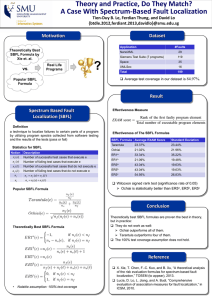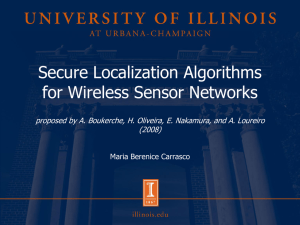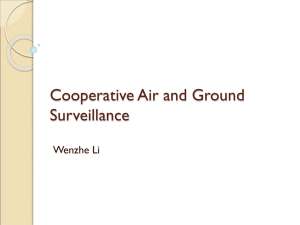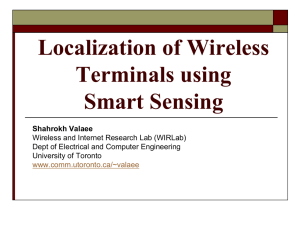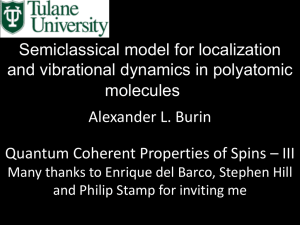Conduction electrons propagate diffusively in the system: bumping
advertisement
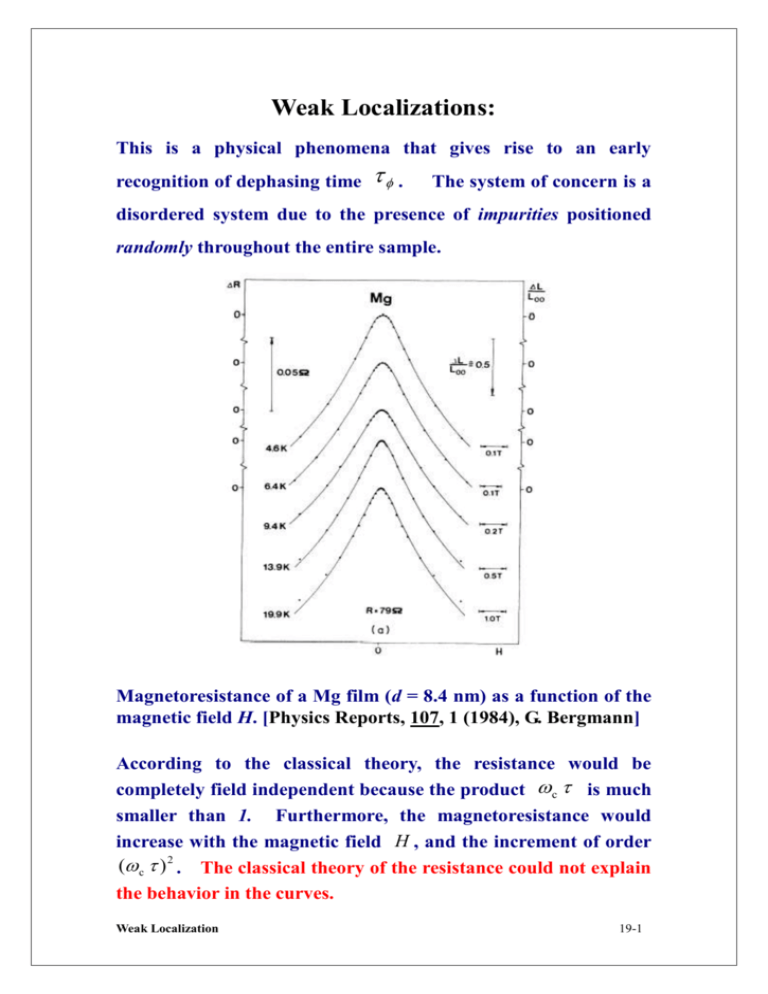
Weak Localizations: This is a physical phenomena that gives rise to an early recognition of dephasing time . The system of concern is a disordered system due to the presence of impurities positioned randomly throughout the entire sample. Magnetoresistance of a Mg film (d = 8.4 nm) as a function of the magnetic field H. [Physics Reports, 107, 1 (1984), G. Bergmann] According to the classical theory, the resistance would be completely field independent because the product c is much smaller than 1. Furthermore, the magnetoresistance would increase with the magnetic field H , and the increment of order ( c ) 2 . The classical theory of the resistance could not explain the behavior in the curves. Weak Localization 19-1 Conduction electrons propagate diffusively in the system: bumping against the random impurities on their way. In contrast to the classical diffusion, the electrons still maintain their capability to undergo interference. That is, they maintain their phase coherence: they have kept track of their phases, even though their phases have changed a lot during their many collisions with the impurities. The electrons are said to undergo quantum diffusion. Diffusion path of a conduction electron. The starting point is O. The solid and the dashed lines denote a pair of timereversed paths for the electron to return to its starting point. Key result: Since the amplitudes add coherently, the quantum diffusion probability to return to the origin is twice as in classical diffusion. Weak Localization 19-2 Possible random paths between positions A and B due to elastic scatterings: Probability PAB of going from A to B is 2 PAB Ai Ai Ai A*j 2 i i j i where Ai is the probability amplitude for the i-th path. The term AA i j i * j is the interference term. Since Ai contains the random phases due to the random positions of the impurities involved in the i-th path, one might think that Weak Localization AA i j i * j averages to zero. 19-3 Dropping the term AA i j i * j reproduces the classical transport results from Boltzmann equation, and Drude model. But for the path that involve position O, there are actually two time-reversal looping paths starting and ending at O. (In the momentum space, we can say k k that the electron starts out with and ends at ) Since the impurities involved in these two paths are the same, the interference term between them do not average to zero. It turns out that the probability of finding the electron at O is twice that of the classical result because of the quantum interference. Therefore, the probability of finding the electron at B is decreased, indicating a drop in the conductance. We will discuss in more detail in the following using the momentum space point of view. Weak Localization 19-4 Coherent backscatterings in disordered conductors: Interference between two time-reversal scattering processes An electron k is scattered to k via time-reversal scattering sequences A or A . Sequence A : k k1 k2 k3 k Sequence A : k k1 k2 k3 k A’ A” Weak Localization 19-5 Sequence A and sequence A have the momentum transfer occurs in opposite order. The scattering amplitudes A A A if the system has time reversal invariance. Total intensity for backscattering is : A A B B 2 2 2 4 A 4 B In contrast, the classical (Boltzmann) result is A A B B 2 2 2 2 2 2 2 A 2 B Weak Localization 19-6 Weak Localization 19-7 Z :assumed number of intermediate states available for elastic scattering (within a thin shell around the Fermi surface) An ( k k ) :probability amplitude for n scattering processes sequence A An ( k k ) An ( k k ) 1 Z n/ 2 i e Interference intensity is A A c.c. 2/ Z * n Total interference intensity for n event sequence: 2 n Z n 1 1 1 Z 2 Z For a n event sequence, the electron are scattered into n-1 n 1 intermediate states, therefore there will be Z / 2 distinct n event sequence. The factor 1 / 2 is to correct for double counting. Weak Localization 19-8 Estimation for Z the number of intermediate states: / shell thickness where k v F lel el is the elastic mean free path. d Z (for one spin state only) 1 L Z 2 el 2 2 A Z 2 kF 2 el (2 ) 3 Z 4 kF2 3 el (2 ) Weak Localization 19-9 Scattering from k k q : Phase difference i where ( Ei En i ) ( i q v Fi . 1 2 2 ) pi pi q 2m Total phase difference n q v Fi i 1 2 2 2 2 n 2 q v Fi i 1 v F2 / d q 2 ( n ) D q2t A A* A A e i Total interference intensity for n scattering events sequence: 1 i ( q ) e Z Weak Localization 19-10 e i e Effective number of states near N coh d (2 ) d Dq2t k that are still coherent: d d qe Dq 2 t Coherent intensity due to backscatterings I coh For N coh Z d 2: I c o h kF e tl for t 0 ( 0) p e t / dt ( p ) 1 p 1 kF ne 2 ( 0) m el kF el t dt ln 1 1 kF el ln ne 2 e2 2 ln m 2 Weak Localization 19-11 k Contribution of the electron state to the momentum as a function of time: the original state and its momentum decay exponentially within the time constant 0 . But an echo with the momentum k is formed with depends on time as 1/ t . This echo reduces the contribution of the electron to the current and yields a correction to the resistance which is proportional to ln( / ) . Weak Localization 19-12 Dephasing time due to magnetic field: : Phase difference between the two complementary waves due to the presence of a magnetic field H. The probability amplitudes become A' A'0 e i(e / ) Adr A" A"0 e c ; i(e / ) Adr cc such that A' A"* A'0 A'*0 e where BA is i ( 2e / ) Adr c A'0 A'*0 e i ( 2e / ) the magnetic flux (out of the page) enclosed by the path. ( 2e / ) ; ( 2 Dt ) H 1 H Weak Localization 4eDH 19-13 Magnetosresistance of a Mg film (d=8.4 nm) as a function of H. The points represent the experiment results and the solid curves are fitted with the theoretical weak localization expression. The values for are obtained from the fitting. Weak Localization 19-14 p-GaAs well on (311)A substrate: 2.5 k F l 5 (a) The magnetoconductivity xx just on the metallic side of the transition for temperatures of 147, 200, 303, 510, and 705 mK. (b) A plot of 1 / versus temperature for densities close to the metal-insulator transition. Solid symbols are data obtained from this study; open symbols are data from Si MOSFETs, Ref. [15]. [Ref.: Simmons et al Phys. Rev. Lett. 84, 2489 (2000)] The solid curves in (a) are theoretical fit: ( B ) e2 h 1 Bo 1 B , 2 B 2 B digamma function and Bn n Weak Localization where ( x ) is the . 4eD 19-15 Effects of spin-orbit scattering: Magnetoresistance of the same Mg film (in the previous second graph) after superposition with 0.25 atomic layers of Au. The points represent the experimental results. The solid curves are calculated with the same set of as in the previous second graph but with a new time constant Weak Localization so . 19-16 00 1 H 1 H 1 1 H 1 1 H 1 2 3 4 2 H 2 2 H 2 2 H 2 H where 00 e2 2 2 , ( x ) is digamma function, and H1 H 0 H so H s H 2 ( 4 / 3) H so ( 2 / 3) H s H H 3 2H s H H 4 ( 2 / 3) H s ( 4 / 3) H so H Weak Localization 19-17 A physical picture for the spin-orbit effects: [Ref: G. Bergmann, Solid State Commun. 42, 815 (1982)] The form of the spin-orbit interaction Vkk ' 1 i k k ' s Vkk ' 1 iK s yields a rotation of the spin s by angles K i around the i -th axis. When the particle is scattered from state k s to k s' , the accumulative effects on the spin add up to a finite rotation R such that s' R s . For the complementary (time-reversed) scattering process, k s" where the final state becomes s' R 1 s . Therefore the interference term will contain an additional 2 factor s" s' s R s . cos(/2)e i( )/2 R i ( ) / 2 isin ( / 2)e isin ( / 2)e i ( ) / 2 cos( / 2)e i ( ) / 2 where , , and are the angles rotating about the original axes in the order z , x and then z axis. [Ref.: Feynman Lecture III, p.6-12] Weak Localization 19-18 2 2 i ( ) The factor s" s' sin ( / 2) cos ( / 2) e for spin up (+ sign) s state or for spin down (- sign) s . Case 1: If there is no spin flip, then all angles are zero. s" s' 1 , we have the regular weak localization. Case 2: If the spin-orbit coupling is strong, the spin state s diffuses on the surface of the sphere in the following diagram. The orientation of the final spin states are statistical. s" s' ave Therefore the average 1 2 and we have the anti-localization. Weak Localization 19-19


